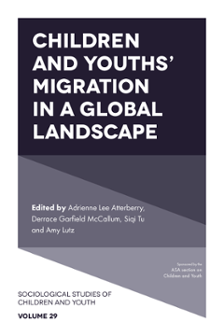
Index
Children and Youths' Migration in a Global Landscape
ISBN: 978-1-80117-539-5, eISBN: 978-1-80117-538-8
ISSN: 1537-4661
Publication date: 24 May 2022
Citation
(2022), "Index", Atterberry, A.L., McCallum, D.G., Tu, S., Lutz, A. and Bass, L.E. (Ed.) Children and Youths' Migration in a Global Landscape (Sociological Studies of Children and Youth, Vol. 29), Emerald Publishing Limited, Leeds, pp. 193-200. https://doi.org/10.1108/S1537-466120220000029014
Publisher
:Emerald Publishing Limited
Copyright © 2022 Adrienne Lee Atterberry, Derrace Garfield McCallum, Siqi Tu and Amy Lutz
INDEX
Note: Page numbers followed by “n” indicate notes.
- Prelims
- Introduction – Children and Youths’ Migration in a Global Landscape: Young Lives Lived in Motion
- Chapter 1: The “Borderlandization” of Mexico: Mexico’s New Policies of Deportation and Detention of Minor Migrants and their Effects on Migrant Movement
- Chapter 2: Young Immigrants’ Integration into a New Home: The Case of Central American Children and Youth Settling in Washington, DC
- Chapter 3: Transnational Migration, Ethnic Identity, and Blurred Boundaries: Indian American Youth Redefine Being a Second-Generation Immigrant
- Chapter 4: Marginality at School: The Experience of Immigrant Children in Rural Italy
- Chapter 5: Muslim Youth, Religion, and Educational Aspirations: The Case of West African Immigrants in New York City
- Chapter 6: The Limits of Trading Cultural Capital: Returning Migrant Children and Their Educational Trajectory in Hungary
- Chapter 7: A Transnational Opportunity Trap? The Missing Link Between Educational Attainment and Future Prospects for Myanmarese Migrant Students in Thailand
- Chapter 8: Globalisation, Human Capital Accumulation and Dynamics of Transnational Migration of Youth: The Case of India
- Conclusion – Children and Youths’ Migration in a Global Landscape: Lessons Learned and Future Directions
- Index